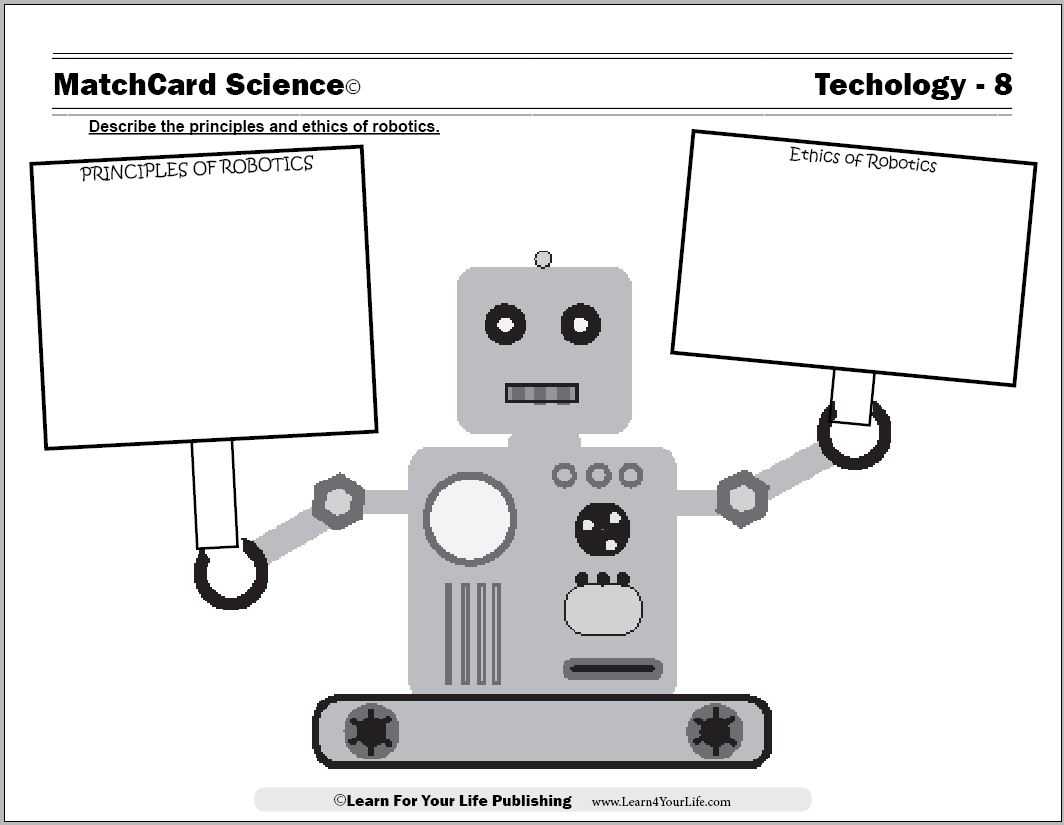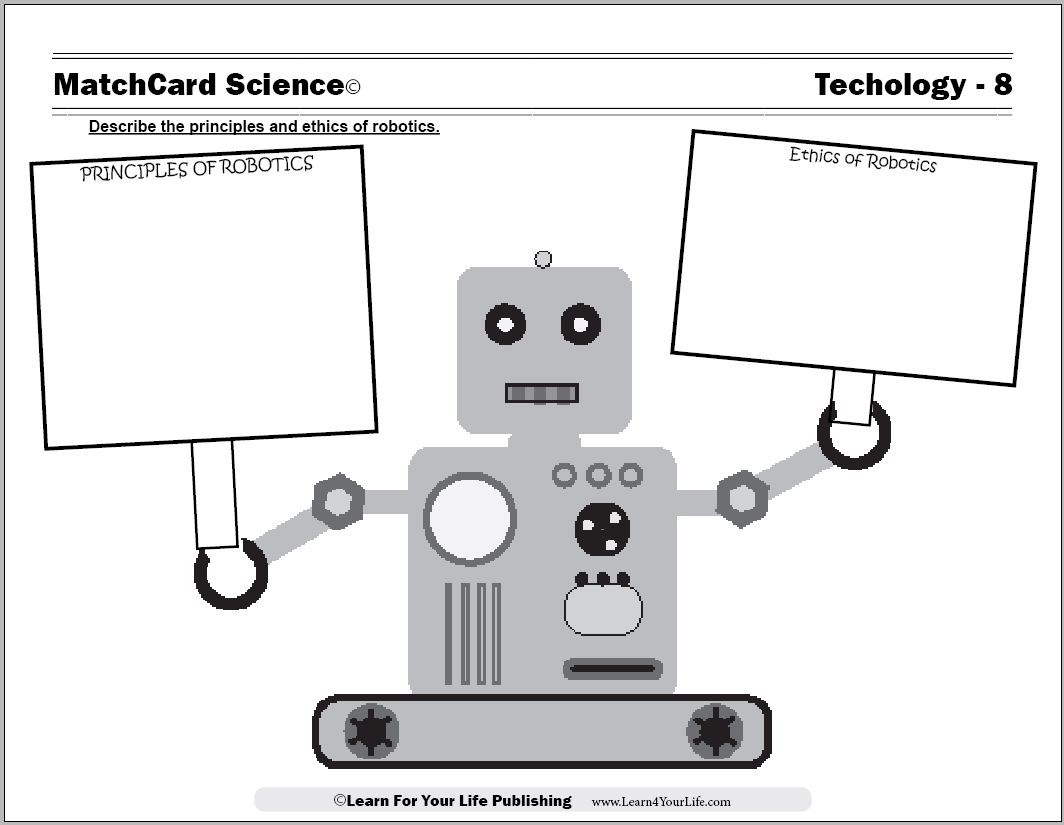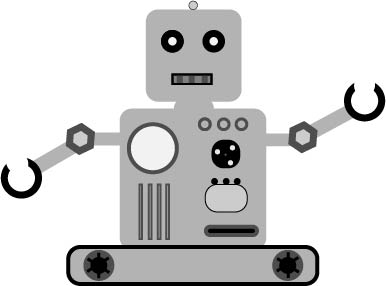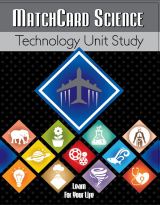Robotic Lesson Plans
Principles of Robotics & Ethics of Robotics for Kids
Free Download Below


MatchCard Science Robotics Lesson Plans
Objective: Describe the 6 principles of robotics and 3 laws of ethics of robotics.MatchCard: Download below.
MatchCard Information Pieces are matched to the principles and ethics of robotics. Ideas for projects are listed on the instructor's page and below.
Print the Robotics MatchCard


Click image to go to download.
This is MatchCard #8 of the Technology Unit Study. Find more information on MatchCard Science below.
Opening Activity
Engaging Students in the Robotics Lessons
Ask your studen(s):- What is a robot?
- Can you list robots (in fiction & real life?)
Let's Watch
Before going further, let's break out the popcorn and watch a 1960's episode of the Jetson Family.As an alternative: Look for pictures of toy robots from the 1960s - perhaps Rock em Sock em Robots
Teacher’s Note: The reason for the emphasis on 1960’s robots is to demonstrate that robots were not originally computerized - though that is a current characteristic.
Let's See What they Know
Ask:How many characteristics of robots can you name? There is a total of 6 characterstics of robots - do you think you can name them all? (Don’t worry if you can’t - you will learn them soon.)
Important Point!
Ok, before we look closer at what a robot is, there is something you need to know. There is NO perfect definition of robot that covers every robot out there.Why not? Well, to begin with, one of the principles of robotics is that robots are computerized. But the household robot in the Jetson’s as well as the robot toys of the 1960’s were basically pre-computer. So while there are some general characteristics that describe robots, and principles of robotics that are used to teach how to make robots, there are exceptions.
Principles of Robotics

Did you read those statements carefully? If so, let’s check your memory and see how many of those seven principles you can recite. Here they are below:
- Mechanical device
- Mobile
- Performs at least one function (or task)
- Has human or animal characteristics
- Has a sensor to detect environmental conditions
- Computerized with a CPU or microprocessor
Using the Information Pieces
Cut the three Info Pieces apart and rearrange them. Practice putting them together and matching the second part and first part of the statements.Discussion & Activities On Human and Animal Robots
How is a stero-typical robot like a human? How is it different?Are you familiar with any animal-like robots? Look up information on the US Marine Alpha Dog Robot.
Microprocessor vs CPU
Students learned about CPU's in the Computer MatchCard. So how is a CPU like a microprocessor? They perform the same function but the micro version is newer and smaller. Why is the microprocessor used for robots?(Hint: Size)
Let the Robots Review
Here's an activity for reviewing the principles of robotics after doing some of the hands-on activities or discussion activities below.Each student can pretend he or she is a robot. Walk and talk like a robot. As you move around, can you recite all those characteristics. Like: “I am a robot. I am a mechanical device. I can move....”
Making a Robot
Okay, where’s the fun in talking about bots without making one yourself? We will list some robotic kits and give instructions for making a robotic hand.Popular Robotics Kits
Here are a few kits to look into:- 4M Robot Kits ($10 - $15)
- KitHub Walking Robot from Cup ($20)
- Lego Wall-E ($60)
- Wonder Workshot Dot Robotics ($50-$150)
- Fishertechnik Automation Robot ($250)
Make Your Own Robotic Hand
Instructions for making your own robotic hand out of bendable drinking straws is included in the MatchCard Science Technology Unit Study. Instructions are also available at other sites on the internet.This is a low-cost, non-computerized activity that helps students grasp some of the concepts of mechanical mobility.
Ethics of Robotics
Ethics is a systematic study of what is right and what should and should not be allowed.Isaac Asimov was a physicist and author who wrote science fiction books about robots. He developed the three laws of ethics which are stated on the robots sign on the Answer Key.
Do you agree or disagree with those laws?
Discussion Questions on Ethics of Robotics
- Do you agree with the first law?
- According to this law, is it ethical to have robotic soldiers?
- Can the military use any robots ethically?
- Is there a difference between the military and local law enforcement's use of robots for lethal force?
- Do you think super artificial intelligence will ever allow robots to program themeselves or rewrite the programs humans put in them?
- What is the implication of the third law? Teacher’s Note: The third law implies that humans are more valuable than robots.
Closing Activity on the Robotics Lesson
Develop A Fictional Robot
You started by listing the robots (real and fictitious) you could think of. Maybe you would like to develop your own robot - fictitiously of course.- What animal or human characteristics will it have?
- What functions can it perform?
- How will it move?
- Will it obey the three laws of ethics?
- What is it’s name?
We hope you enjoyed this lesson about robotics. Check out the other eight Technology MatchCards as well as the other eleven MatchCard Science Unit Studies.
MatchCard Science
How To Use MatchCards

Download the FREE MatchCard Science Instructor's Guide and see how MatchCards can make building their science knowledge base fun.
12 Science Unit Studies

Chemistry is only one of twelve complete unit studies for kids in 3rd to 8th grade.
Comprehensive objectives, hands-on projects, suggested science fair experiments, and the fun game-like MatchCards keep them interested in learning science. See all twelve MatchCard Science Unit Studies.
About Our Site
Hands-On Learning





